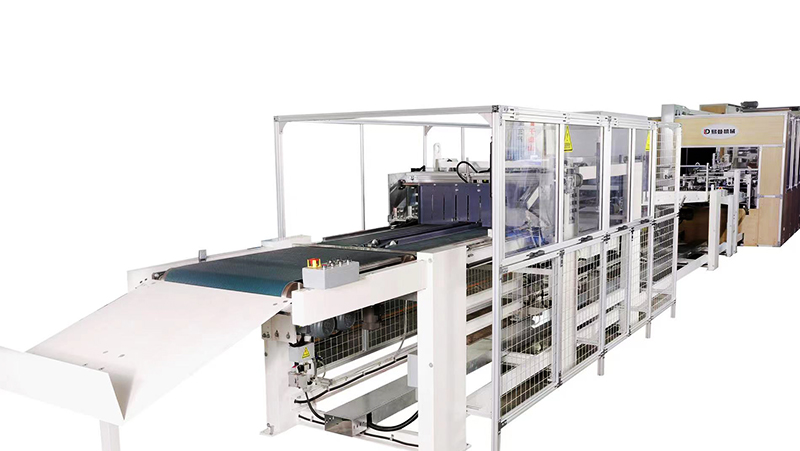Achieving Carbon Neutrality in Modern Paper Bag Manufacturing: Technology, Processes, and Sustainability
Release time:2025-05-19 Classification:Knowledge
The global shift toward sustainable packaging solutions has placed paper bags at the forefront of eco-friendly alternatives to single-use plastics. As industries prioritize environmental responsibility, the development of carbon-neutral paper bag production lines has emerged as a critical innovation. This article explores the technological advancements, operational strategies, and sustainable practices that define modern carbon-neutral paper bag manufacturing systems.

1. The Framework of Carbon-Neutral Production
A carbon-neutral paper bag production line is designed to balance greenhouse gas emissions with equivalent carbon removal or offsetting measures. This holistic approach spans raw material sourcing, energy consumption, manufacturing processes, and end-of-life disposal. Key components include:
- Renewable Energy Integration: Production facilities increasingly rely on solar, wind, or hydropower to replace fossil fuel-dependent energy sources. On-site renewable energy systems, coupled with energy-efficient machinery, significantly reduce operational carbon footprints.
- Closed-Loop Material Sourcing: Sustainably managed forests and recycled paper fibers form the foundation of raw material procurement. Advanced pulping technologies minimize waste, while certifications ensure adherence to reforestation and biodiversity standards.
- Emission Capture and Offset Protocols: Technologies like carbon capture systems mitigate unavoidable emissions during production. Remaining emissions are neutralized through verified offset programs, such as reforestation initiatives or renewable energy investments.
2. Advanced Manufacturing Technologies
Modern production lines incorporate cutting-edge technologies to optimize efficiency and sustainability:
- High-Speed, Low-Energy Machinery: Automated systems with servo-driven motors reduce energy consumption by up to 40% compared to conventional equipment. Precision cutting and forming mechanisms minimize material waste.
- Water-Based Adhesives and Inks: Traditional solvent-based adhesives are replaced with biodegradable, non-toxic alternatives. Similarly, plant-derived inks eliminate volatile organic compound (VOC) emissions.
- Heat Recovery Systems: Waste heat from drying and pressing stages is captured and reused, lowering overall energy demand.
3. Life Cycle Assessment (LCA) Integration
Carbon neutrality requires rigorous evaluation of the product’s entire lifecycle. Production lines now integrate LCA software to:
- Quantify emissions at each stage, from forestry operations to distribution.
- Identify energy-intensive processes for targeted improvements.
- Validate offset strategies through third-party audits.
4. Waste Reduction and Circular Economy Practices
Zero-waste principles are embedded in carbon-neutral systems:
- Recycled Fiber Utilization: Post-consumer waste paper constitutes 60–80% of raw materials in leading systems, reducing reliance on virgin pulp.
- Byproduct Repurposing: Residual paper dust and trimmings are converted into biomass fuel or composite materials.
- Reusable Packaging Designs: Bags are engineered for durability, enabling multiple uses before recycling.
5. Challenges and Solutions
While carbon-neutral production is achievable, challenges persist:
- Energy Storage Limitations: Intermittent renewable energy sources necessitate investments in battery storage or grid-balancing technologies.
- Cost of Carbon Offsetting: High-quality offset programs require significant capital, though economies of scale are gradually lowering expenses.
- Supply Chain Transparency: Blockchain-enabled tracking systems are being adopted to verify sustainable sourcing claims across global supply chains.
6. Future Trends and Industry Outlook
Innovations poised to redefine carbon-neutral paper bag manufacturing include:
- AI-Driven Optimization: Machine learning algorithms that predict energy demand and adjust operations in real time.
- Carbon-Negative Materials: Experimental fibers derived from agricultural residues or algae that sequester more carbon than they emit.
- Modular Production Units: Compact, decentralized factories powered entirely by renewables, reducing transportation-related emissions.
The transition to carbon-neutral paper bag production lines represents a convergence of environmental stewardship and industrial innovation. By leveraging renewable energy, circular economy principles, and advanced technologies, manufacturers can deliver functional, sustainable packaging solutions without compromising productivity. As regulatory pressures and consumer demand for eco-conscious products intensify, carbon neutrality will transition from a competitive advantage to an industry standard—a vital step toward a net-zero future.






